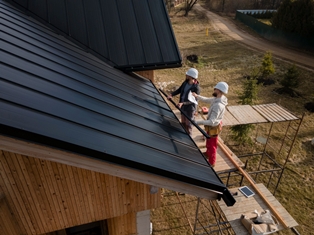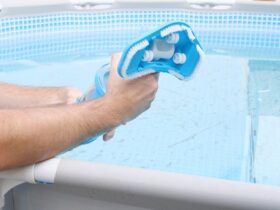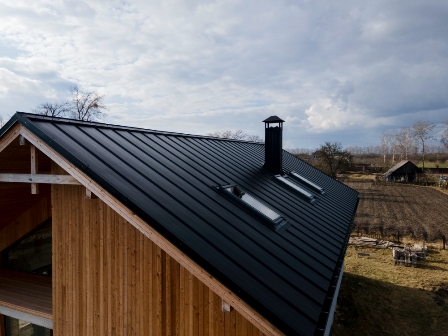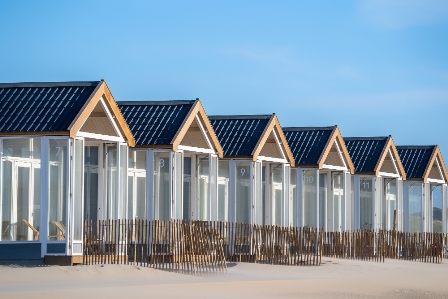Metal roofing has emerged as a modern and durable solution for protecting homes and buildings against the elements. Unlike traditional roofing materials like asphalt shingles or tiles, metal roofing offers a host of benefits that make it an attractive choice for homeowners and businesses alike.
What is Metal Roofing?
Metal roofing refers to roofing materials made from metal, such as steel, aluminum, copper, or zinc. These materials are specifically designed to withstand harsh weather conditions, including heavy rain, snow, wind, and extreme temperatures.
Benefits of Metal Roofing
Metal roofing provides several advantages over conventional roofing materials. Some of the key benefits include:
- Durability:
Metal roofs are exceptionally durable, boasting a lifespan of 50 years or more when properly maintained.
- Weather Resistance:
Metal roofing is resistant to damage from rain, snow, hail, and high winds.
- Energy Efficiency:
Metal roofs reflect sunlight, reducing heat absorption and lowering cooling costs in hot climates.
- Aesthetic Appeal:
With a wide range of styles and colors available, metal roofing can enhance the appearance of any home or building.
- Environmentally Friendly:
Metal roofing is often made from recycled materials and can be recycled at the end of its lifespan, reducing waste and environmental impact.
- Fire Resistance:
Metal roofing is non-combustible, providing added protection against fire.
Types of Metal Roofing Materials
Metal roofing is available in various materials, each with its own unique properties and benefits.
Steel
Steel is one of the most common materials used in metal roofing due to its affordability and strength. It can be coated with zinc or other materials to enhance durability and corrosion resistance.
Aluminum
Aluminum roofing is lightweight and corrosion-resistant, making it ideal for coastal areas or regions with high humidity. It is also recyclable, making it an eco-friendly choice.
Copper
Copper roofing is prized for its beauty and longevity. Over time, it develops a natural patina that adds character to the roof while providing exceptional durability.
Zinc
Zinc roofing offers excellent corrosion resistance and requires minimal maintenance. It is often used in contemporary architecture for its sleek appearance.
Installation Process
Installing a metal roof requires careful planning and execution to ensure a long-lasting and watertight seal. The installation process typically involves the following steps:
Preparation
- Roof Inspection:
Assess the condition of the existing roof and make any necessary repairs or replacements.
- Underlayment Installation:
During the installation process, it’s crucial to install a waterproof underlayment beneath the metal roofing panels. This underlayment acts as an additional barrier, protecting against leaks and ensuring the long-term integrity of the roof.
Installation Steps
- Metal Panels:
Install metal panels starting from the eaves and working your way up to the ridge.
- Fastening:
Secure the metal panels to the roof deck using screws or clips.
- Flashing:
Install flashing around roof penetrations, such as chimneys or vents, to prevent water infiltration.
Hiring a Professional vs. DIY
While some homeowners may opt to install a metal roof themselves, hiring a professional roofing contractor is often recommended. Professionals have the experience and expertise to ensure the job is done correctly and safely, minimizing the risk of leaks or damage to the roof.
Durability and Longevity
One of the key advantages of metal roofing is its exceptional durability and longevity. Metal roofs can last 50 years or more with proper maintenance, making them a long-term investment in the protection of your home or building.
How long does metal roofing last?
Metal roofing can last 50 years or more with minimal maintenance, outlasting many traditional roofing materials like asphalt shingles or wood shakes.
Maintenance Tips
- Regular Inspections: Inspect your metal roof annually for signs of damage or wear.
- Clean Gutters: Keep gutters clear of debris to prevent water from backing up and causing leaks.
- Trim Trees: Trim overhanging branches to prevent damage from falling debris.
Energy Efficiency
Metal roofing offers significant energy savings by reflecting sunlight and reducing heat absorption into the building. This can result in lower cooling costs, particularly in hot climates.
Reflectivity and Insulation
Metal roofs reflect solar radiation, reducing the amount of heat transferred into the building. Additionally, insulation can be added to further improve energy efficiency and comfort.
Impact on Energy Bills
By reducing the need for air conditioning, metal roofing can lead to lower energy bills and increased savings over time.
Cost Considerations
While the initial cost of metal roofing may be higher than traditional materials like asphalt shingles, its long-term benefits often outweigh the investment.
Initial Investment
The cost of a metal roof depends on factors such as material, size, and complexity of the installation. However, metal roofing typically costs more upfront than asphalt shingles or wood shakes.
Long-Term Savings
Metal roofing offers significant long-term savings through reduced maintenance and energy costs. With proper care, a metal roof can last 50 years or more, outlasting many other roofing materials and minimizing the need for costly repairs or replacements.
Environmental Impact
Metal roofing is a sustainable choice for environmentally conscious consumers, offering several eco-friendly benefits.
Sustainability
Many metal roofing materials are made from recycled materials, reducing the need for raw resources and minimizing waste.
Recyclability
At the end of its lifespan, metal roofing can be recycled and used to make new products, further reducing its environmental impact and conserving resources.
Common Misconceptions
Despite its many benefits, metal roofing is sometimes subject to misconceptions that can deter homeowners from choosing this durable and long-lasting roofing option.
Noise During Rain
Contrary to popular belief, modern metal roofs are not louder during rainstorms than other roofing materials. Proper insulation and underlayment minimize noise transmission, creating a quiet and comfortable indoor environment.
Lightning Attraction
Metal roofing does not attract lightning any more than other roofing materials. In fact, metal roofs are non-combustible and can safely dissipate electrical charges in the event of a lightning strike.
Denting from Hail
While metal roofing can dent under extreme hailstorms, it is typically more resistant to damage than other roofing materials like asphalt shingles or wood shakes. High-quality metal roofing materials are designed to withstand hail and other severe weather conditions.
Safety Concerns
Metal roofing offers several safety benefits, including fire resistance and improved traction to prevent slipping hazards.
Fire Resistance
Metal roofing is non-combustible, providing added protection against fire and reducing the risk of property damage in the event of a fire.
Slipping Hazards
Textured coatings can be applied to metal roofs to improve traction and reduce slipping hazards, particularly in wet or icy conditions.
Comparisons with Other Roofing Materials
When comparing metal roofing to traditional materials like asphalt shingles or tile, it’s essential to consider factors such as durability, maintenance requirements, and energy efficiency.
Asphalt Shingles
Asphalt shingles are a popular roofing material due to their affordability and ease of installation. However, they have a shorter lifespan and may require more frequent repairs and replacements than metal roofing.
Tile Roofing
Tile roofing is known for its durability and aesthetic appeal, particularly in Mediterranean-style architecture. However, it can be heavy and expensive to install, and individual tiles may crack or break over time.
FAQs (Frequently Asked Questions) Section
Metal roofs can last 50 years or more with proper maintenance, making them one of the most durable roofing options available.
Modern metal roofs are often installed with proper insulation, minimizing noise from rain and other external sources.
Contrary to popular belief, metal roofs do not attract lightning any more than other roofing materials. They are designed to safely dissipate electrical charges.
While DIY installation is possible for those with experience and the right tools, hiring a professional ensures the job is done correctly and safely, minimizing the risk of damage to your property.
Conclusion
Metal roofing offers a modern and durable solution for protecting homes and buildings against the elements. With its variety of materials, styles, and colors, metal roofing provides long-lasting protection, energy efficiency, and aesthetic appeal for homeowners and businesses alike. Whether you’re building a new home or replacing an existing roof, consider the many benefits of metal roofing for a sustainable and stylish roofing solution.











Find Us on Socials